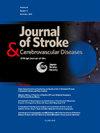急性缺血性脑卒中患者神经源性应激性心肌病的患病率及其与白细胞增多的关系。
IF 2
4区 医学
Q3 NEUROSCIENCES
Journal of Stroke & Cerebrovascular Diseases
Pub Date : 2025-01-01
DOI:10.1016/j.jstrokecerebrovasdis.2024.108169
引用次数: 0
摘要
目的:探讨急性缺血性脑卒中患者神经源性应激性心肌病的发病特点。描述白细胞增多作为神经源性应激性心肌病的炎症标志物。材料/方法:回顾性分析某三级保健中心688例成人缺血性脑卒中患者(2018年1月- 2021年12月)。神经源性应激性心肌病可通过左心室射血分数低、室壁运动异常、肌钙蛋白- 1升高或脑钠肽升高来确定。白细胞增多定义为白细胞计数≥12.0 × 10^9/L。收集临床和人口统计数据。结果:147例(21%)患者出现神经源性应激性心肌病。本组患者平均年龄68岁,女性占44%,美国国立卫生研究院卒中量表平均10分,平均住院时间8天。其中64%的患者左心室射血分数低(中位数为40%),40%的患者肌钙蛋白- i升高(中位数为0.252 ng/mL), 55%的患者心室壁运动异常。卒中机制为隐源性(43%)、心栓性(24%)、小血管疾病(13%)、大动脉粥样硬化(12%)和其他(8%)。平均白细胞计数为8.63 × 10^9/L。心肌病患者白细胞增多率为12%,无心肌病患者为8%,差异无统计学意义(p=0.9)。结论:我们建议通过四种心脏生物标志物之一来定义神经源性应激性心肌病。患病率与先前的报告一致,最常见的是低左心室射血分数或心室壁运动异常。与Takotsubo心肌病不同,异常的壁运动模式主要是弥漫性的。各组间白细胞计数无明显差异。需要进一步的研究来确定神经源性应激性心肌病的危险因素。本文章由计算机程序翻译,如有差异,请以英文原文为准。
Prevalence of neurogenic stress cardiomyopathy in acute ischemic stroke and relationship with leukocytosis
Objective
Describe the prevalence and features of neurogenic stress cardiomyopathy in acute ischemic stroke. Describe leukocytosis as an inflammatory marker in neurogenic stress cardiomyopathy.
Materials/Methods
Retrospective review of 688 adult ischemic stroke patients at a tertiary care center (1/2018 – 12/2021). Neurogenic stress cardiomyopathy was identified by one of: low left ventricular ejection fraction, ventricular wall motion abnormalities, elevated Troponin-I, or elevated brain natriuretic peptide. Leukocytosis defined as white blood cell count ≥12.0 × 10^9/L. Clinical and demographic data were collected.
Results
Neurogenic stress cardiomyopathy was observed in 147 (21 %) patients. In this group, mean age was 68, 44 % were female, mean National Institutes of Health Stroke Scale was 10 and mean hospital stay was 8 days. Low left ventricular ejection fraction (median 40 %) was observed in 64 % of these patients, elevated Troponin-I (median 0.252 ng/mL) in 40 %, and ventricular wall motion abnormalities in 55 %. Stroke mechanisms were cryptogenic (43 %), cardioembolic (24 %), small vessel disease (13 %), large artery atherosclerosis (12 %), and other (8 %). Mean white blood cell count was 8.63 × 10^9/L. Leukocytosis occurred in 12 % of patients with cardiomyopathy and 8 % without, with no significant difference (p=0.9).
Conclusion
We propose defining neurogenic stress cardiomyopathy by one of four cardiac biomarkers. The prevalence aligns with prior reports, most frequently identified by low left ventricular ejection fraction or ventricular wall motion abnormalities. Unlike Takotsubo Cardiomyopathy, abnormal wall motion patterns were predominantly diffuse. No significant difference in leukocytosis was found between groups. Further research is needed to identify neurogenic stress cardiomyopathy risk factors.
求助全文
通过发布文献求助,成功后即可免费获取论文全文。
去求助
来源期刊

Journal of Stroke & Cerebrovascular Diseases
Medicine-Surgery
CiteScore
5.00
自引率
4.00%
发文量
583
审稿时长
62 days
期刊介绍:
The Journal of Stroke & Cerebrovascular Diseases publishes original papers on basic and clinical science related to the fields of stroke and cerebrovascular diseases. The Journal also features review articles, controversies, methods and technical notes, selected case reports and other original articles of special nature. Its editorial mission is to focus on prevention and repair of cerebrovascular disease. Clinical papers emphasize medical and surgical aspects of stroke, clinical trials and design, epidemiology, stroke care delivery systems and outcomes, imaging sciences and rehabilitation of stroke. The Journal will be of special interest to specialists involved in caring for patients with cerebrovascular disease, including neurologists, neurosurgeons and cardiologists.
 求助内容:
求助内容: 应助结果提醒方式:
应助结果提醒方式:


